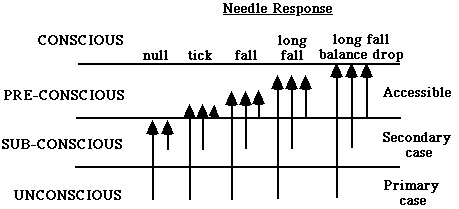Use of the Biofeedback Monitor
by Peter Shepherd
The object of therapy is to bring into the light of inspection, old inappropriate programmes or behaviour patterns and their corresponding imprinted decisions and postulates. This does not necessarily demand looking into the past; the patterns and decisions will be active in the present, especially if the topic being addressed is one that the client particularly has their attention on, or is concerned about.
The meter helps the analyst to discover these key items, since when the client's attention is drawn to an item, the charge on the item will cause an increase in tension and in brain arousal, which is visible on the meter as a sudden fall in resistance, i.e. an instantaneous fall of the needle. (The needle is much quicker to fall in response to tension than to rise in response to relaxation, this being a characteristic of the autonomic nervous system; 'reads' on the meter are therefore easily distinguishable from hand movements or fidgeting, which causes an equally fast rise and fall).
The needle will first react to items when they are just below conscious awareness, i.e. in the pre-conscious mind and therefore accessible to conscious inspection. There will always be a minimum response time of 0.4 second, whilst the nerve conducts the impulse to the hand electrode. The pre-conscious response though will come within 0.75 second. A reaction time of approximately 1.5 seconds correlates with the first aware (i.e. conscious) reaction. It is the pre-conscious reaction that is of most interest, since we are trying to coax into awareness the repressed parts of mental content.
A fast needle movement that stops very suddenly as though the needle had hit a wall indicates material that is heavily repressed with a defence mechanism (this may correspond to guilt) and has been forced back into the sub-conscious. The faster the needle reaction, the greater the emotional content. A large reaction indicates that the item is both near to the surface and also that it is ready to be faced. When the read is indicated to the client, he will have more than an inkling of what the buried item is and be able to pull the material and examine it objectively.

It should be noted that even a 'tick', a tiny response of the needle, means that an item is available. While a tick or small fall may not be related to significant case, very often such items are actually more heavily repressed and are the 'tip of an iceberg', connecting with the primary case of the unconscious. It is therefore important to spot the feelings, emotions, appearance and comments of the person on the meter, as these reflect the depth of the charge that is being contacted.
A 'balance drop' is a long fall of resistance that stays down for a period, and usually accompanies a conscious realisation about the material being viewed. When the analytic process begins, the restimulation of the subject will tend to cause an increase of basal resistance or 'mass' and the balance rises. As the introspection occurs and the item is cleaned of charge, the balance drops. This means arousal increases but also, in this context, it means less withdrawal, less inhibition from past patterns and therefore the subjective feeling is one of greater freedom. Insight will have been gained and when the client feels that the problem is solved and the charge has been released, his attention is in the present and a 'free needle' results, oscillating gently and evenly over an area that may be up to a dial wide.
This mini-satori may be accompanied by considerable excitement and the subjective feeling of 'That's great!' or 'I know that's true'. It is the indicator that that stage of the procedure has reached an endpoint and a break is then normally the best idea. A release though, is not necessarily a full erasure, and an insight is not necessarily the whole truth. So depending on the Transformational Psychology procedures in use, often it is necessarily to take this item up again and explore where that leads. For this purpose the Bilateral meter, which measures and compares the arousal of the two brain hemispheres, is most appropriate.
Move on to Incremental Changing of Habit Patterns.
Return to Transforming the Mind - Contents.